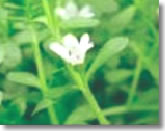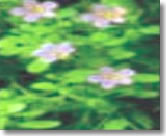
BRAHMI
Botanical name: Bacopa monnieri(SCROPHULARANCEAE)
English name :Indian pennywort
Hindi Name: Barmi, Jalanima

Introduction: This plant is known for its memory enhancing properties for a very long time in India medicine. Atharva Parisista (1/44/10) and other vedic texts did mention Brahmi. It is often mistaken for Mandukaparni which is botanically identified as Centella asiatica. But both are different plants possessing pharmacologically similar properties. Brahmi is known for its utility in psychiatric and neurological conditions. It is used by Indian folklore as well as urban household for the children to improve the memory. Various commercial formulations are also available today in the market.
Distribution: A glabrous, punctata, succulent herb which is common in the moist places throughout India
Chemical Constituents: Brahmine, herpestine, hersaponin, monnierin (saponin), bacoside A & B, bacogenins A1 – A4 (sapogenins ) etc.
Parts Used : Whole plant.
Properties: Bitter – astringent, cooling, brain tonic, antioxidant, anti-epileptic, febrifuge etc.
Indications: epilepsy, schizophrenia, stress conditions, amnesia, fevers, inflammatory conditions, skin diseases etc.
Does: Fresh juice 10- 20 ml.
Therapeutic Uses
- Apasmara : sesamum oil, garlic, Shatavari, brahmi, Kuth & vacha are given with honey.
- Erruptive fevers: Juice of Brahmi is rally administered with honey.
Scientific Studies
Memory enhancing activity: EE improved the process of motor learning in rats (Prakash & Sirsi,1962).At 40 mg/kg. orally for 3 or more days showed better acquisition, improved retention and delayed extinction of treated rats (J. Ethnopharmacol. 1982,5,205).
Phsychotropic activity: EE (10-200 mg/ 100g b.w.) had a sedative effect on frogs and dogs (Malhotra & das, 1959). EE of whole plant (50 mg/kg i.p.) exhibited transquilizing effect on albino rats & dogs (Aithal & Sirsi, 1961). Hersaponin showed a sedative effect in mine (Malhotra et al., 1960 1961 & 1962). Plant extract showed significant barbiturate hypnosis potentiation in rats (J .res. Ind. Med. Yoga & Homoeo . 1979,14,1).
Anti- cancer activity : The EE of whole plant was found to have anti-cancer activity against walker carcinosarcoma 256 (i.m.) in rat (Bhakuni et al.,1969).
Cultivation Technology: It is a prostrate herb, rooting at nodes and grows well in loam to sandy-loam soils where plenty of water is available . The plant is susceptible to frost during winter so require shade in these conditions. The field should be well ploughed, rich in oganic matter and irrigated a day before planting of cuttings. 5-7 cm long cutting having root at nodes are planted at a distance of 30*30 cm in the month of July- august. The field is flooded just after planting and 2-3 irrigations per week are required during dry and hot months.
Harvesting: Mature leaes are cut from the base with the help of sickle leaving 4-5 cm stumps for subsequent regeneration.







